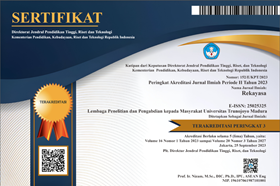Analisis Efektivitas Fitoremediasi Berbasis Tanaman Hias pada Konsentrasi Formaldehida Dalam Ruangan untuk Meningkatkan Health and Safety Pekerja
Abstract
Indoor air quality is a crucial factor that directly impacts worker safety and health (K3), where exposure to hazardous pollutants such as formaldehyde can trigger irritation, respiratory disorders, and long-term health risks. Based on this issue, this study aims to analyze in depth the effectiveness of a phytoremediation strategy using ornamental plants in reducing formaldehyde concentrations in office workspace environments. To achieve this goal, sophisticated simulations were conducted using Computational Fluid Dynamics (CFD) methods through the SimScale platform. Four main intervention scenarios were modeled in detail: (1) a control condition with no intervention, (2) the use of mechanical ventilation alone, (3) ornamental plant intervention alone, and (4) a synergistic combination of ventilation and plants. In this simulation, formaldehyde emissions were assumed to originate from the work desk material, while the ornamental plant Ficus benjamina acted as a passive absorbing agent. The simulation results showed that the combination of ventilation and plants was the most superior strategy, capable of drastically reducing formaldehyde concentrations by up to 99.8% in just one hour. Meanwhile, plant intervention alone also made a significant contribution with a reduction of 46%. Further statistical analysis using multiple linear regression and ANOVA confirmed that all interventions had highly significant effects (p < 0.05). Furthermore, it was revealed that plant placement influenced absorption effectiveness, with positions closer to the emission source showing better absorption. These findings emphasize the importance of an integrated strategy between plant arrangement and ventilation engineering to create a healthy, safe, and productive work environment.
Keywords
Full Text:
PDF (Bahasa Indonesia)References
Ahmad, F. (2022). Implementation of occupational safety and health (K3) for increasing employee productivity. Jurnal Economic Resources, 5(2).
Aripratama, K. P. (2021). Kajian Fitoremediasi Ruangan Dalam (Indoor) dari Pajanan Formaldehid dan Partikulat Menggunakan Tanaman Hias dan Pemanfaatan Praktiknya (Doctoral dissertation, Institut Teknologi Sepuluh Nopember).
Azzamudin, R., & Marwan Effendy, S. T. (2017). Analisis Distribusi Aliran Udara Pada Ruangan Dengan Variabel Temperatur dan Penempatan AC Menggunakan Metode Computational Fluid Dynamics (CFD) (Doctoral dissertation, Universitas Muhammadiyah Surakarta).
Bahantwelu, M. (2021). Analisis Pemakaian Displacement AC Dalam Bangunan. GEWANG: Gerbang Wacana dan Rancang Arsitektur, 3(2), 38-44.
Che, W. W., Tso, C. Y., Sun, L., Ip, D. Y., Lee, H., Chao, C. Y., & Lau, A. K. (2019). Energy consumption, indoor thermal comfort and air quality in a commercial office with retrofitted heat, ventilation and air conditioning (HVAC) system. Energy and Buildings, 201, 202-215.
Kaushik, A., Arif, M., Ebohon, O. J., Arsalan, H., Rana, M. Q., & Obi, L. (2023). Effect of indoor environmental quality on visual comfort and productivity in office buildings. Journal of Engineering, Design and Technology, 21(6), 1746-1766.
Khoshakhlagh, A. H., Mohammadzadeh, M., Ghobakhloo, S., Cheng, H., Gruszecka-Kosowska, A., & Knight, J. (2024). Health risk assessment from inhalation exposure to indoor formaldehyde: a systematic review and meta-analysis. Journal of Hazardous Materials, 471, 134307.
Kumar, R., Verma, V., Thakur, M., Singh, G., & Bhargava, B. (2023). A systematic review on mitigation of common indoor air pollutants using plant-based methods: a phytoremediation approach. Air Quality, Atmosphere & Health, 16(8), 1501-1527.
Lai, D., Qi, Y., Liu, J., Dai, X., Zhao, L., & Wei, S. (2018). Ventilation behavior in residential buildings with mechanical ventilation systems across different climate zones in China. Building and Environment, 143, 679-690.
Li, W., & Chen, Q. (2021). Design-based natural ventilation cooling potential evaluation for buildings in China. Journal of Building Engineering, 41, 102345.
Liu, C., Miao, X., & Li, J. (2019). Outdoor formaldehyde matters and substantially impacts indoor formaldehyde concentrations. Building and Environment, 158, 145-150.
Ravindra, K., & Mor, S. (2022). Phytoremediation potential of indoor plants in reducing air pollutants. Frontiers in Sustainable Cities, 4, 1039710.
Sahri, M., & Hutapea, O. (2019). Penilaian kualitas udara ruang pada Gedung perkantoran di Kota Surabaya. Jurnal Higiene Industri dan Kesehatan Kerja , 4 (1), 1-12.
Sharma, S., Bakht, A., Jahanzaib, M., Lee, H., & Park, D. (2022). Evaluation of the effectiveness of common indoor plants in improving the indoor air quality of studio apartments. Atmosphere, 13(11), 1863.
Situngkir, D., Rusdy, M. D. R., Ayu, I. M., & Nitami, M. (2021). Sosialisasi Keselamatan dan Kesehatan Kerja (K3) sebagai upaya antisipasi kecelakaan kerja dan Penyakit Akibat Kerja (PAK). Jurnal Pengabdian Kesehatan Masyarakat, 2(1), 8-17.
Susanto, A. D., Winardi, W., Hidayat, M., & Wirawan, A. (2021). The use of indoor plant as an alternative strategy to improve indoor air quality in Indonesia. Reviews on Environmental health, 36(1), 95-99.
Talaie, A., & Ponraj, M. (2024). Impact of Houseplants on Reducing Indoor Air Pollution. Journal of Environmental Treatment Techniques, 12(3), 1-13.
Teiri, H., Hajizadeh, Y., & Azhdarpoor, A. (2022). A review of different phytoremediation methods and critical factors for purification of common indoor air pollutants: an approach with sensitive analysis. Air Quality, Atmosphere & Health, 15(3), 373-391.
DOI
https://doi.org/10.21107/rekayasa.v18i2.31243Metrics
Refbacks
- There are currently no refbacks.
Copyright (c) 2025 Bilqis Hanifah Inas, Ratna Sari Dewi

This work is licensed under a Creative Commons Attribution-ShareAlike 4.0 International License.
























